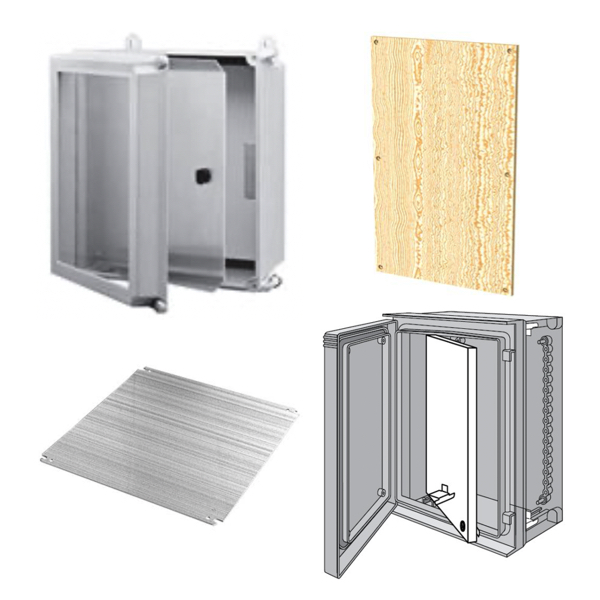Network Cabinet Backplates & Swing-Out Panels

Network backplates and swing-out panels are used for mounting electrical components. Most backplates come with pre-cut holes to match the mounting holes in the enclosure. These panels can be removed or replaced, allowing the components to be easily worked on, without uninstalling the entire network cabinet. Backplates are made of steel, fiberglass, aluminum, wood, galvanized steel, painted steel, as well as composite materials.
Hoffman COMLINE aluminum backplates provide a lightweight, corrosion-resistant mounting surface for electrical components housed inside COMLINE aluminum wall-mount enclosures. The enclosures are ideal for tower-mounted or rooftop telecommunication applications.
Hoffman PROLINE side barrier panels are used between frames to block airflow and provide security between ganged PROLINE cabinets. The barriers fasten to one frame and allow fasteners to secure adjoining frames.
More Information about Network Cabinet Backplates & Swing-Out Panels
Hoffman ULTRX steel panels, wood panels and swing-out panels are installed on ULTRX fiberglass enclosures. The lightweight ULTRX fiberglass WiFi cabinets do not impede WLAN or WiFi signals and are ideal for locations such as outside walls, rooftops, floor vaults and tunnels. The front-mounted swing-out panels compliment window-door units and are suitable for applications that require displaying of dials, gauges and other control equipment monitors.
Hoffman POLYPRO wood panels and aluminum swing-out panels are installed on PLYPRO WiFi enclosures. These enclosures provide protection for wireless equipment in both indoor and outdoor applications. The polyester construction and wood panel allow WLAN and WiFi signals to pass through the enclosures unimpeded.
Drilling and tapping holes into a steel back plane for hardware attachment.
Take inventory of the tools needed for the job. A metal punch is used to make a small divot in the metal so that the drill bit won't wander, a very sharp machine drill bit and a 10-24 tap. The size of the bit and tap will depend on the type of hardware being used to secure the din rail and wire ducting to the panel.
Punch to create divots on previously marked layout. Always punch before drilling and make sure that the punch is in the center of the mark.
Drilling into the steel back plane. Make sure that the drill bit is very sharp, use lubrication to prolong the life of the bit, place the bit into the punched divot and start drilling. Clean up any metal shards when drilling is complete.
Tapping the holes to create threads. Make sure that the tap is very sharp and lubrication is used when tapping the holes. Do not over torque the tap which can cause it to break. Make sure that the tap goes completely through the hole until it turns easily to ensure that the holes have been properly threaded. Test the threaded holes with a screw. Clean up any metal shards. The back plane is now ready for mounting hardware.

